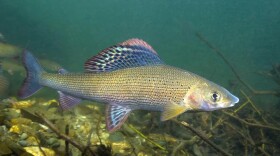-
Adults can submit their best depiction of the fish through March 31 and the student competition closes on April 10.
-
Steamboat Springs can close the Yampa River — a hotspot for tubing, swimming and fishing — when it's too low and hot.
-
Springtime is here and baseball is back. This year, that’s good news for sports fans AND lovers of a threatened fish native to the Colorado River. As Alex Hager reports for the Mountain West News Bureau, one minor league team will take the field as the “humpback chubs” every Wednesday this season.
-
The Wyoming Game and Fish Department finished the bulk of a massive fish conservation project in the Big Sandy water basin. They removed harmful invasive fish that were eating and hybridizing with native species.
-
New research shows that climate change is causing mountain lakes to rapidly lose ice cover in the winter. That can harm the Mountain West region’s water quality – and native fish.
-
Eastern Idaho and western Wyoming are hotspots for salmon shares from Bristol Bay, Alaska. Customers are increasingly buying wild sockeye in bulk because they say it tastes better, and they want to support small businesses.
-
We zoom in on a water restoration project in southwest Wyoming, the headwaters of the Colorado River system that serves about 40 million people downstream. The goal is to restore the surrounding habitat and ultimately hold water on the landscape longer, a problem that's plaguing all of the West. And one way to address that? Humans acting like beavers.
-
Wildlife agencies are purchasing 3,345 acres of ranchland in the Mountain West that serves as a critical habitat for several species, including a threatened Western fish.
-
A new study looks into how many fish are in reservoirs across the U.S., and what role these ecosystems could play in conservation and food security.
-
The Interior Department is spending another $70 million to reopen habitat for native fish in many parts of the U.S., including the Mountain West.
© 2026 Wyoming Public Media
800-729-5897 | 307-766-4240
Wyoming Public Media is a service of the University of Wyoming
800-729-5897 | 307-766-4240
Wyoming Public Media is a service of the University of Wyoming

Play Live Radio
Next Up:
0:00
0:00
Available On Air Stations










